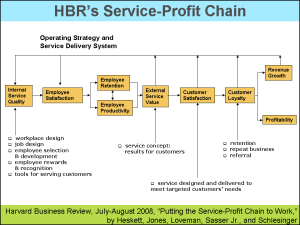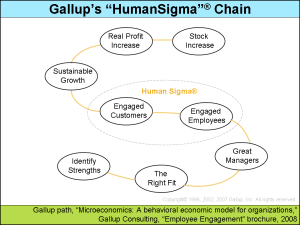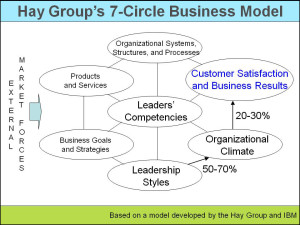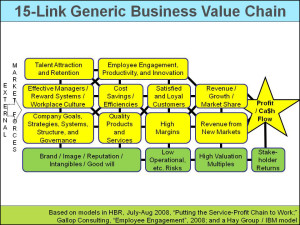A 15-Link Generic Business Value Chain

The March-April 1994 issue of the Harvard Business Review (HBR) featured a seminal article, “Putting the Service-Profit Chain to Work,” by James L. Heskett, Thomas O. Jones, Gary W. Loveman, W. Earl Sasser, Jr., and Leonard A. Schlesinger. At that time, I was working in IBM Canada’s Leadership Development department.
The article was a welcome reinforcement for the important role that mangers play in building an energizing and empowering work environment for their employees—a foundational link in a chain of value leading to company success.
HBR reprinted that article in its July-August 2008 issue in its “Best of HBR” series. By then, I was eight years into my next career as an author and speaker on the business relevance of sustainability-based strategies. I’m still impressed by how the service-profit chain provides a valuable web of interrelated business goals which sustainability-related strategies can help achieve better and faster. I am convinced that the credibility and effectiveness of sustainability champions is improved if we show how our suggested approaches contribute to the success of one or more links in the business value chain. This week, we’ll look at a few versions of the value chain, and conclude with a touchstone generic business version to add to sustainability champions’ toolkits.
The HBR 9-link service-profit chainHBR’s “Putting the Service-Profit Chain to Work” article focused on the value of designing a workplace environment that creates satisfied, productive employees. Why? Satisfied, productive employees serve customers better. Satisfied customers are more loyal. Loyal customers buy more, which generates higher revenue, profits, and growth. The HBR article establishes a generic set of connections from engaged employees through to higher profits.
There is no mention of corporate social responsibility or sustainability in this value chain. It is about how to run a successful business, period.
The Gallup 8-link value chainGallup Consulting’s “Employee Engagement” brochure, published in 2008, includes the adjacent figure. In the brochure, the S-curve is labeled “Gallup Path Microeconomics: A behavioral economic model for organizations.” The dotted Human Sigma© circle in the middle connects engaged employees to engaged customers, and indirectly to subsequent improved growth, profit, and stock price.
Great managers contribute to engaged employees; so does the “right fit” for the employee in the organization. Just as the previous HBR service-profit chain shows, the Gallup economic model emphasizes the human / employee element as the gate to stronger profits.
The Hay Group 7-circle business modelWhen I was in Leadership Development in IBM Canada, we used a corporate leadership model from the Hay Group, one of the world’s largest human resources consulting firms. The Hay Group model portrays seven critical and intertwined aspects of any business that managers must address for their company’s success. We liked it because it reinforces the importance of leaders’ styles and competencies when creating an engaging organizational climate for employees.
Hay Group’s research has shown that 20 to 30% of the variance in revenue and profit in organizations can be attributed to the differences in organizational climate. We called the leadership competencies, leadership styles, and organizational climate the “soft stuff,” and used the 7-circle model to show their critical importance when achieving the “hard Stuff”—business results.
A 15-link generic business value chainBuilding on elements in the above three value chains, I propose the adjacent 15-link model. It shows what it takes for a company—any company—to be successful. It’s generic. It applies to any for-profit company, in any industry, anywhere. It connects the dots between the soft stuff, like workplace culture and employee engagement, and the hard stuff, like better quality products, services, and profits.
It is robust, complete, and shows the interdependencies between the foundational, organizational culture elements on the left and the business results on the right.
So, now we have a clear model of a successful business for our tool kit. It is our credibility credential. Using it shows that we know what it takes for any business to be successful. We want the company to be a winner—with stronger links in its value chain than its competitors. That’s why we’re recommending our (sustainability) strategies as a way to energize one or more critical business building blocks / links. That is, hard-nosed business leaders will pay attention to our recommendations because they are relevant to their company’s success. We will explore more about setting up that relevance next week.
Bob
The PowerPoint slides used above are from my Master Slide Set.
Please feel free to add your comments and questions using the Comment link below.








Comments are closed.